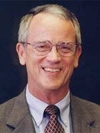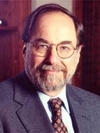The presidents of MIT and Caltech have announced a collaborative project to develop an easy-to-use, reliable, affordable and secure United States voting machine that will prevent a recurrence of the problems that threatened the 2000 presidential election.
The announcement was made in a joint video news conferences at MIT and Caltech on Thursday.
"It is embarrassing to America when technology fails and puts democracy to such a test as it did this month," said Caltech President David Baltimore, who opened the hour-long live teleconference in Pasadena, California.
"Academic institutions have a responsibility to help repair the voting process so that we don't see anything like this again. This project is intended to protect the system from the problems we've seen in the last election," Dr. Baltimore said.
MIT President Charles M. Vest, speaking from Cambridge, echoed Dr. Baltimore's concern for the security and credibility of the voting process.
"We must find a solution. Each of us must be confident that his or her vote has been reliably recorded and counted. A country that has put a man on the moon and an ATM machine on every corner has no excuse," said Dr. Vest.
"America needs a uniform balloting procedure. This has become painfully obvious in the current national election, but the issue is deeper and broader than one series of events," said Vest and Baltimore in a Dec. 12 letter to President Vartan Gregorian of Carnegie Corporation of New York.
Gregorian said, "I want to congratulate the two presidents of our nation's most distinguished universities for their leadership in this welcome and timely initiative on behalf of our election system. Voting is the fundamental safeguard of our democracy and we have the technological power to ensure that every person's vote does count. MIT and Caltech have assembled a team of America's top technology and political science scholars to deal with an issue no voter wants ignored. This research is certain to ensure that America's voting process is strengthened." Gregorian said he will recommend the Carnegie Corporation board fund the $250,000 initial phase of the research.
The grant will be used by a team of two professors from each university who are experts in technology, design and political science. The four members of the team are Massachusetts Institute of Technology Professors Stephen Ansolabehere of political science and Nicholas Negroponte, chairman of the MIT Media Lab; and Caltech Professors Thomas Palfrey of political science and economics and Jehoshua Bruck of computation and neural systems and electrical engineering.
Lessen confusion
Professor Ansolabehere, speaking at the teleconference, said, "We are going to consider voting technologies from the paper ballots of the nineteenth century to the latest. First, we'll look, literally, at what people do in the voting booth. There, our goal is to lower voter confusion.
"Second, we'll look at how votes are counted, comparing the precinct level to a central counting agency. We will look at the strengths and weaknesses of voting technologies, find the greatest weakness and work from there. Our goal is to find the most reliable among existing technologies."
The first phase of the joint project -- surveying existing technologies and setting up criteria -- would be complete in about six months, Professor Ansolabehere added.
Professor Palfrey of Caltech noted there were "issues that didn't hit the press in Florida but that are critical, including comparing the cost of existing technologies to the cost of standardization and modernization, which could run into several billions of dollars.
"But compare that one-time cost to the $300 billion annual defense budget. It's a small price to pay for modernizing democracy," he said.
Professor Palfrey also noted other issues for the MIT-Caltech team to explore, such as the impact of the current system of election administration, which is "highly decentralized and fragmented," and the role of absentee voting, with its implied concerns of security, liability, privacy, maintenance and software development.
Feedback
Professor Negroponte, chairman of the MIT Media Lab, spoke to his bi-coastal colleagues and the media about the actual interface between people and any voting machine.
"Whatever is invented will include some interface with machines, whether we vote by computer, paper or in a voting booth. The Media Lab intends to make that interface as easy as possible," he said.
Professor Negroponte outlined the goals of the joint project from the perspective of design and feedback by comparing the act of voting with the act of pushing a button to summon an elevator.
"Right now, there's no feedback at all in voting. You push the button. Nothing happens. It's like when you push the elevator button and nothing happens: you don't know if the elevator is broken or the light is broken. It would be good to have some degree of feedback in voting. For example, you might get some feedback saying, 'you voted for x,'" he noted.
ATM the model
The MIT-Caltech faculty team took a generally lighthearted view of the alleged challenges to the public of mastering new voting technology, despite months of media attention to voter confusion over the various forms of ballots and punch-card machines that didn't punch.
"Beware of the assumption that newer technology is more complicated. The trend is the opposite," said Dr. Vest. "Most people have been able to figure out ATMs. That's our model," remarked Dr. Baltimore.
Vest and Baltimore said the new technology "should minimize the possibility of confusion about how to vote, and offer clear verification of what vote is to be recorded. It should decrease to near zero the probability of miscounting votes... The voting technology should be tamper-resistant and should minimize the prospect of manipulation and fraud."
The two university presidents proposed that their institutions give the project high priority for two major reasons:
"First, the technologies in wide use today are unacceptably unreliable. This manifests itself in at least three forms: undercounts (failure to correctly record a choice of candidate), overcounts (voting for two candidates), and missed ballots (machine failure or feeding error). Punch cards and optically scanned ballots are two of the most widely used technologies, and both suffer unacceptably high error rates in all three categories. For example, in the recent Florida election, optical scanning technology had an undercount rate of approximately 3 out of 1,000, and the punch card undercount rate was approximately 15 out of 1,000. Including the other two sources of errors, the overall ballot failure rate with machine counting was about three times this.
"Second, some of the most common types of machinery date from the late nineteenth century and have become obsolete. Most notably, many models of lever machines are no longer manufactured, and although spare parts are difficult to obtain, they are still widely used (accounting for roughly 15 percent of all ballots cast).
Replacing lever machines
"States and municipalities using lever machines will have to replace them in the near future, and the two most common alternatives are punch cards and optical scanning devices. Ironically, many localities in Massachusetts have recently opted for lever machines over punch card ballots because of problems with punch cards registering preferences."
Asked to comment on the project as scientists, both university presidents noted the convergence of history and technology as being especially promising for the development of a new voting machine.
"This is a project we could have tackled any time, but the truly bizarre circumstances of the recent presidential election put it on the front burner. We are also at a technological point where a solution is highly likely," said Dr. Vest.
"There are times when events overtake us. This is a good time and a necessary time to be doing this," said Dr. Baltimore.
The Massachusetts Institute of Technology and the California Institute of Technology have a relationship dating back to 1920 when MIT scientists helped shape the chemistry and physics departments of the new California Institute of Technology. Dr. Baltimore, a 1975 Nobel laureate, served on the MIT faculty from 1968-90 and 1994-1997, when he was appointed president of Caltech.
News Conference Video
View the December 14, 2000 MIT/Caltech news conference in RealVideo.
You will need the free RealPlayer from Real.com to view the video.







